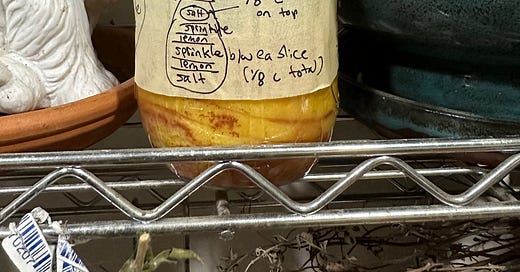This is the paid version of my newsletter. Thank you so much for your support of my work: It means the world!
Do you know someone who might like my work? Please send them to the link below to sign up!
First off, an invitation:
Pickling party: bring your summer harvest and come preserve with me!
Please join us for our latest workshop: Pickling Party, happening this Saturday at 11 AM EST.
It's free for all paid subscribers: Details below!
One thing I love about recipe testing is viewing the whole thing as a process, not just a destination.
When we give ourselves over to the process, it becomes so much more fun: we create space for questions and their resulting insights to emerge, and for serendipity to guide us, rather than barreling towards a destination without stopping to admire the scenery. When something doesn't work, it becomes a space for learning and asking, rather than beating yourself up (or getting mad at the recipe itself).
I know fellow food writers who are in one or the other camp or some, like me, who vacillate between the two. I mostly thrive in the process: My kitchen right now is covered in sticky notes and bits of masking tape, scribbled on in a hurry, to make sure I remembered a proportion or the order in which I packed ingredients into a jar. It's chaos, but beautiful chaos, and chaos I thrive in.
Improvised fermentation weights are a good example of this chaos. Sure, you can buy fermentation weights (and I have my fair share), but anything from a (clean) river stone to a plate to another jar can be used as a weight.
As part of my ethos of using simple tools with intention, I teach students in my fermentation classes to work with what they have on hand: The fermentation weight we use most often in our classes (and the same one I recommend in Our Fermented Lives) is a folded cabbage leaf, tucked inside a jar atop to-be sauerkraut to keep everything under the brine.
I've been thinking about improvisation and fermentation weights this week as I've been making preserved lemons.
Keep reading with a 7-day free trial
Subscribe to Root: Historic Food for the Modern World to keep reading this post and get 7 days of free access to the full post archives.




